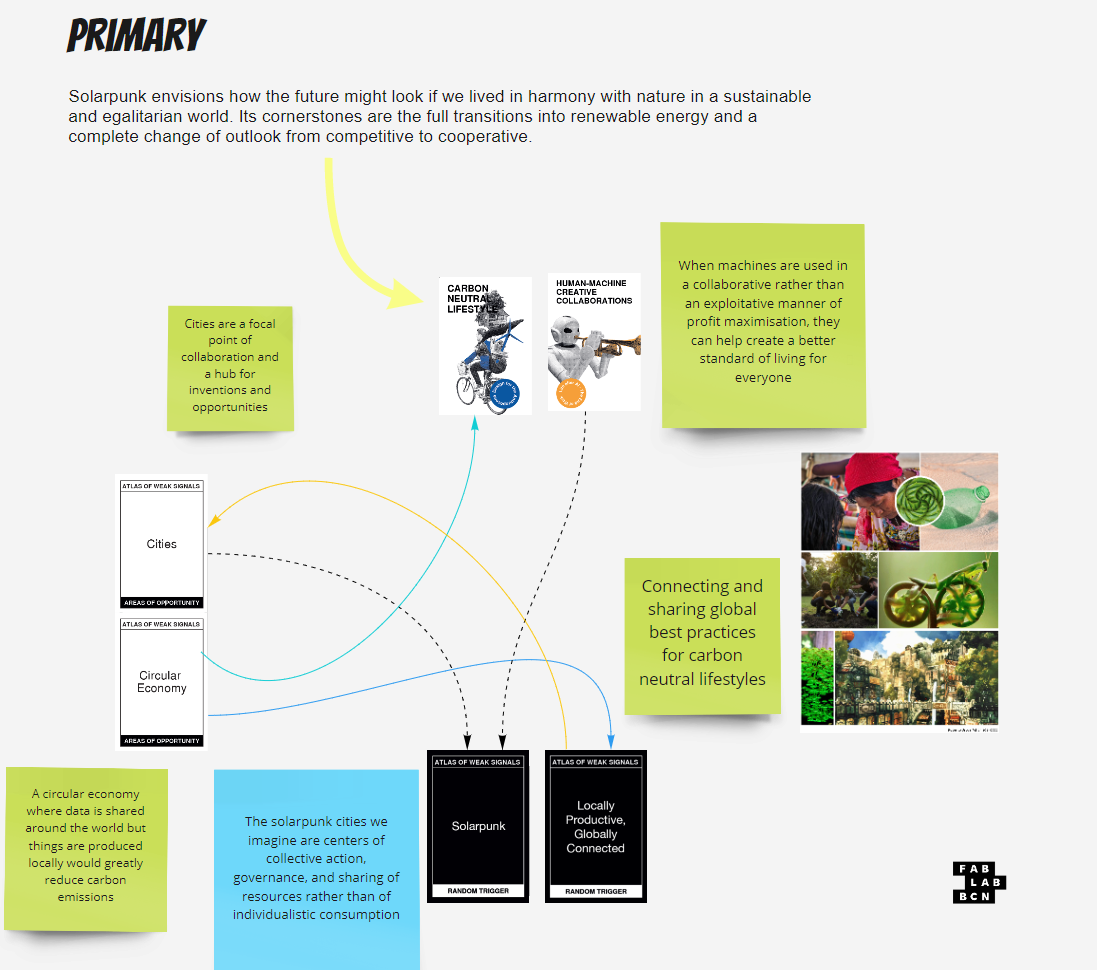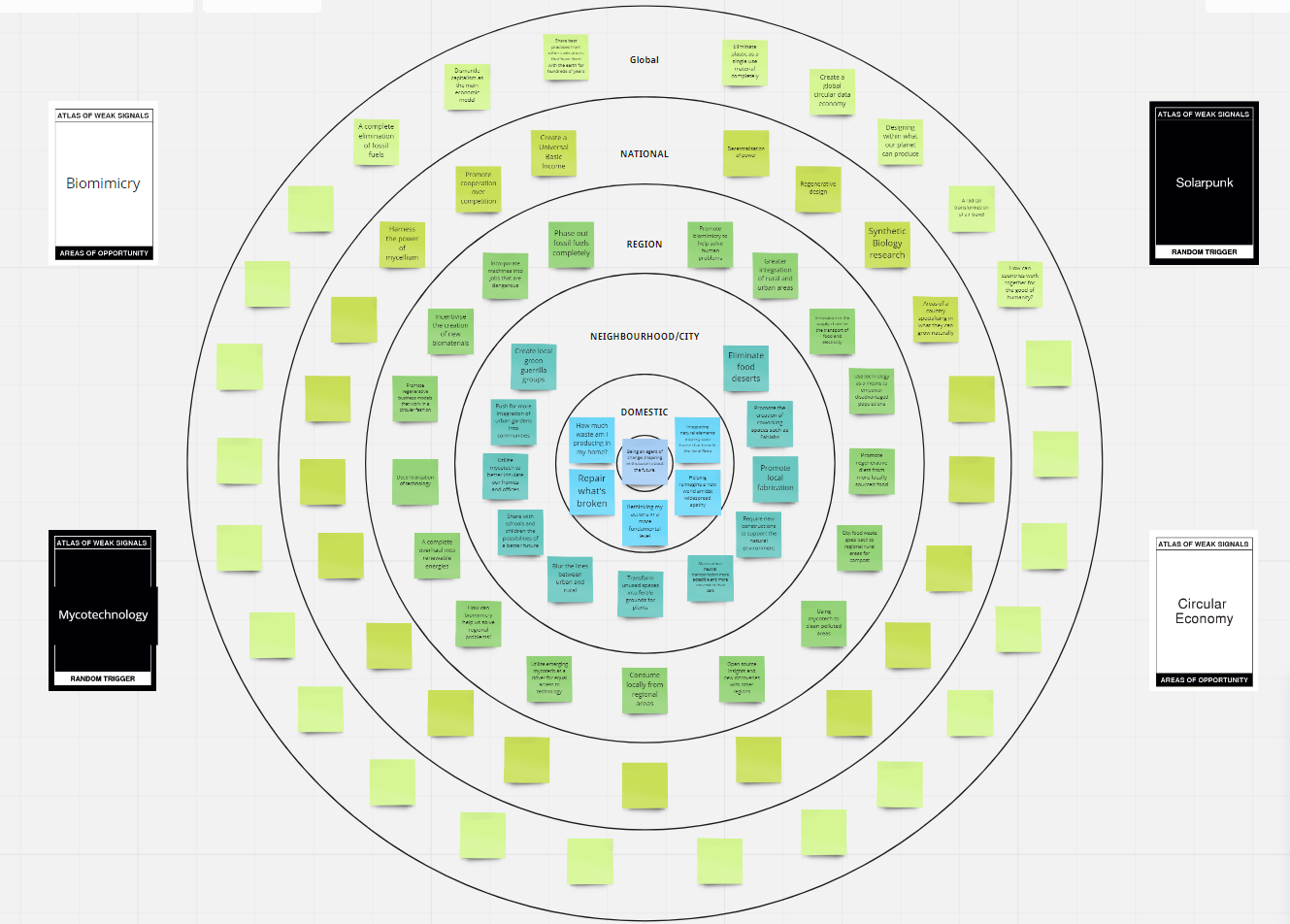
Creating a Personal Design Space
We began our Atlas of Weak Signals journey with an initial warm-up exercise through which we'd choose a weak signal and then we'd pick another at random from a pile of turned-down cards. We'd then compliment these cards with additional cards from the "areas of opportunity" and the "random triggers" stacks. Once everything was chosen, we'd find connections between these cards and complement them with thoughts and references.
This exercise helped me to think outside of the constraints of what I thought was directly connected, and pushed me to create new links between topics that were previously thought unrelated to me.
Afterwards, we created our Design Spaces with all of the possible weak signals, areas of opportunity, and random triggers. Despite having complete freedom to use as many cards and expand the space as possible, I decided to constrain myself to only the most important ones for my primary design board. This forced me to think about which weak signals I truly identified with the most.
I chose Solarpunk and Circular Economy as my main weak signals. I chose these two as my main weak signals because they both are all-encompassing philosophies of an envisioned future where we have as a society progressed from an economic model of exploitation to one of collaboration.
These Solarpunk cities are centers of collective action, governance, and sharing of resources rather than of individualistic consumption. Alongside a complete overhaul into renewable energy, this systemic change would address the root causes of inequality that lead to unequal access to tools and opportunities.
A Solarpunk future features a human-centric, as well as a nature-centric model where we prosper alongside nature. This would require us to grab the prime examples from the world's first design teacher and create a perfect circular economy where all byproducts are used and counted for, thus eliminating the concept of "waste". A circular economy takes into consideration every aspect of a material's life-cycle at the time of creation, so that at the end of it's 1st life cycle it transforms and serves a different purpose. The concept of waste puts a heavy burden on the natural world that takes several generations to decompose, all while heavily damaging the beings that cross the waste's path during this process of decomposition. This approach is thus neither human-centric nor nature-centric.
These weak signals relate directly to my fight as they both answer one very simple question: "Is this action helping move humanity forward in a way that will allow my grandchildren, and my grandchildren's grandchildren to enjoy the planet the way I am?"
Download Files
Design Space Primary
Design Space Secondary

Multiscalar Diagram
Once we finished our personal design space, we then moved on to creating multiscalar diagrams. These multiscalar diagrams grab a weak signal and scale it up from the individual to a global level. I grabbed the weak signals of Solarpunk, Biomimicry, Mycotechnology, and Circular Economy.
I realised the exercise got progressively more difficult as I scaled up. It was easier and more accesible to think of questions, ideas, and interventions at a community and city level than it was to think of global changes that the nations of the world could do. The weak signals manifested themselves through grassroots movements, government policies, and individual actions. They also envisioned the possibilities these weak signals had of solving problems that would emerge in a later future, and that could be subsequently solved utilising these same measures.
Download Files
Multiscalar Diagram

Collaboratory Design Space
Our collaborative space was a very interesting one. It was basically made up of those thaat featured "Rural Futures" as their main weak signal and those that featured some variant of Climate Justice. After an initial discussion and an effort to try and connect our main weak signals, many new pathways and discussions emerged. All of the topics fell under a "Solarpunk" umbrella, to which I could explain how rural futures, machine-human collaboration, a carbon neutral lifestyle, and environmental justice were all intrinsically connected under one same purpose of nature-human centric approaches with machinery tools that could open up a new way of life away from rampant consumerism. This created an abundance of collaboration ideas and possible emergent futures. Additionally, it also greatly helped me understand the point of view and motivations of my fellow classmates.
Download Files
Collaboratory Design Space
Next steps
For my next few steps I would like to indulge a little more in a very Solarpunk topic I was very interested in even before starting MDEF: Fungi. I had done some research regarding various kinds of plastic eating fungi and I found an open field of exploration available to me. I would like to experiment with different species of fungi, plastic, and environments to see their aplications and implications. I'm hoping to make close connections with Nuria Conde and Jonathan Minchin and seek them as mentors for my project. I would like to connect with Katherine Ungern from Livin Studios that created the only other plastic-eating-fungi conceptual design I could find on Google and ask her about her findings
A new skill I would like to add to my personal development plan is a deeper knowledge of biology and the scientific method. Having a deeper knowledge of microbiology and a habit of reading scientific journals would be very beneficial to my long-term goals of a Solarpunk future.